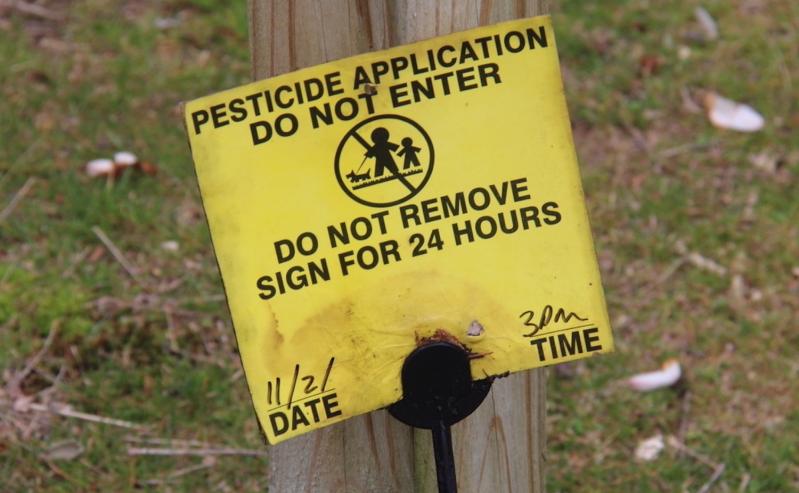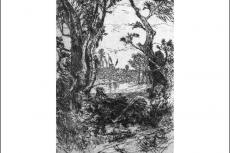The color yellow announces the arrival of spring. Daffodils, forsythia, and pesticide application placards are all in bloom on properties across the South Fork.
Suffolk County leads New York State by a huge margin in pesticide and herbicide diversity and use according to a new report released by the New York State Department of Environmental Conservation last week.
In 2021, a staggering 6,523,568 pounds of pesticides were applied in Suffolk County. To put this number in perspective, Westchester County was in second place, with 2,859,035 pounds of pesticides used. Most counties used less than 100,000 pounds.
The Suffolk County number is even more alarming when one considers it’s the fourth most populous county but ranks 20th for land mass. In other words, more people are crammed per square mile onto the land, and that land is awash in pesticides.
Tamson Yeh, a pest management and turf specialist at the Suffolk County Cornell Cooperative Extension, read through the list of top 10 applied pesticides, in a phone call. She was familiar with each. “You see a lot are turf-related. We do have an awful lot of high-end uses. Upstate, they don’t have such a fascination with their lawns,” she said.
“It’s all about lawn shaming. People are afraid they’re going to be shamed by the neighbors because of the appearance of their lawn. But really, who cares? In agriculture it makes sense to use some of these pesticides and herbicides because you’re trying to harvest a product,” she said.
The vast majority of the 6.5 million pounds of pesticide used here were not applied in the service of raising crops, despite the fact that Suffolk County is often the leading agricultural county in the state based on revenue.
Greenhouses, nurseries, vineyards, and of course, golf courses all push up pesticides’ use. The sod farms in Riverhead and Eastport require a lot. That sod is then transferred piece by piece to the lawns of the South Fork where the cycle of herbicide use continues.
“Pesticide users have to follow the label and that includes ensuring [that] irrigation, mowing and blowing after the applications conform to the label requirements,” the D.E.C. said in an email. The agency “also follows up on complaints of misapplications. Reports of inappropriate applications or related activities can be reported to D.E.C.’s pesticides program staff located in the Stony Brook office.”
“It’s not that there aren’t regulations,” Leonard Green, a co-founder of Changehampton, said by phone, “but it’s such a complex net of interactions, the endless round of fertilizations and use of biocides, it gets so complicated that you have to worry about the consequences.”
Suffolk County also has the dubious distinction of being the county that uses the most diverse range of pesticides, dropping 1,743 different products into the air and onto the land. Nassau County trails behind in second place, at 1,296 products.
Are any of these products reaching our groundwater?
According to the United States Geological Survey, Suffolk County’s single-source aquifer supplies 400 million gallons of water a day.
“Some pesticides have been detected in Long Island’s groundwater over the years, most of the time at very low levels well below drinking water standards,” according to the D.E.C.
The 2021 to 2022 groundwater monitoring data from Suffolk County shows about 48 pesticide-related compounds were detected, with the vast majority at single digit parts per billion levels. Approximately 10 compounds were detected more than a few times, with similar concentrations.
The “D.E.C. is actively involved in protecting Long Island’s groundwater resources, and partners with Suffolk and Nassau Counties to monitor groundwater for pesticides and other contaminants,” a spokesperson wrote. The agency “remains committed to monitoring programs in partnerships with local municipalities and other initiatives that help prevent adverse effects to public health and the environment.” It addd that, “Water suppliers regularly test public water to make sure that levels for more than 100 different contaminants meet strict drinking water standards before they reach the tap.”
Permethrin, often sold to homeowners as a natural compound found in the chrysanthemum flower, sprayed monthly for tick control from April to November, is the number-one insecticide used in the county.
“It doesn’t necessarily protect people if they feel they sprayed and solved the problem,” said Ms. Yeh. “They’re not solving the problem.” Whether or not you spray, nightly tick checks are still recommended for people who spend time outside.
“Studies have shown herbicides and pesticides have a negative impact on the entire ecosystem,” said Mr. Green. “When we negatively impact an ecosystem, we reduce the services that system provides. We’re killing the very means, the plants, microbes, and fungi that would help remediate the excess toxins that we’re putting in the ground.”




